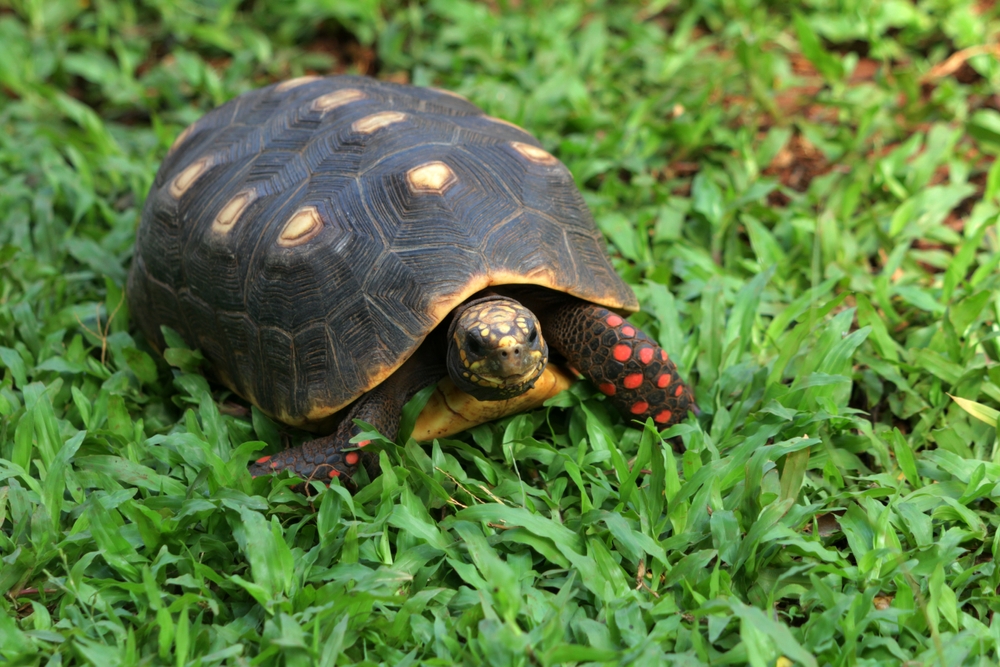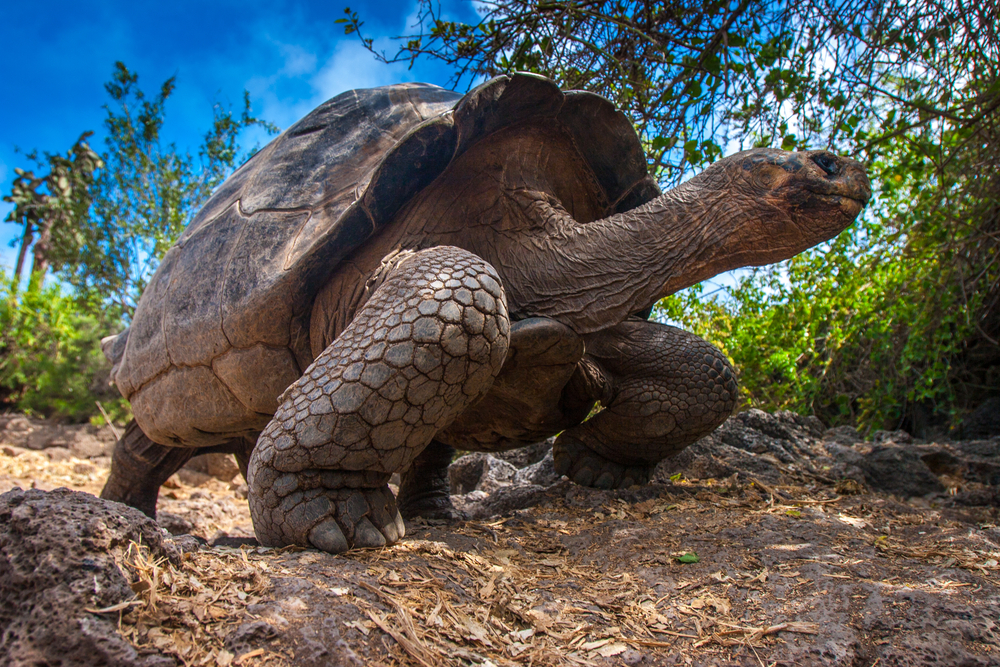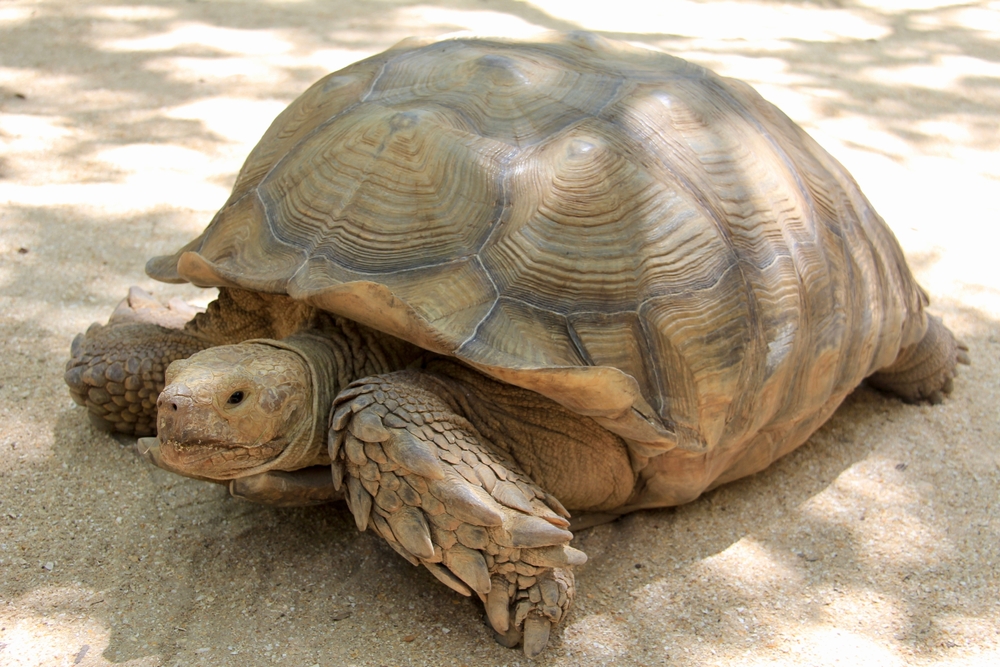The closest species to the red-footed tortoise (Chelonoidis carbonarius) is the yellow-footed tortoise (Chelonoidis denticulatus). Both are native to South America, share similar habitats, and exhibit overlapping behaviors and diets. However, the yellow-footed tortoise is generally larger and has yellow or orange markings on its limbs instead of red.
About
The red-footed tortoise is a medium-sized, tropical tortoise native to South America, particularly in countries like Brazil, Colombia, Venezuela, and the Guianas. It also inhabits parts of the Caribbean, including Trinidad and Barbados. Known for its vivid red, orange, or yellow markings on the legs, head, and tail, this attractive tortoise is popular in the pet trade and plays an important ecological role as a forest-floor scavenger and seed disperser.
Adults typically reach 30–40 cm (12–16 inches) in shell length, though some individuals may grow larger in ideal conditions. They have a domed, dark brown or black carapace with lighter, often yellowish centers on each scute, creating a slightly spotted or radiating pattern. The skin on their limbs is dark with bright red or orange scales, giving them their common name.
Red-footed tortoises are omnivorous, with a diet that includes fruits, flowers, leaves, fungi, and occasionally carrion or invertebrates. Their strong jaws and broad palate allow them to handle a wide variety of foods, and their foraging helps disperse seeds throughout the forest.
They are diurnal and prefer humid, tropical environments, such as rainforests, savannas, and forest edges. While not strong burrowers like their desert relatives, they will seek shelter in vegetation, logs, or shallow scrapes in the ground.
Reproduction is oviparous. Females typically lay 2–7 eggs per clutch, with incubation lasting 4–6 months depending on environmental conditions. Hatchlings emerge with high-domed shells and are fully independent.
Red-footed tortoises are long-lived—often surviving 40–50 years or more in captivity—and are generally hardy when provided with proper humidity, temperature, and diet. In the wild, they face threats from habitat loss and capture for the pet and bushmeat trade.
The red-footed tortoise’s scientific name is Chelonoidis carbonarius, and it belongs to the family Testudinidae.
Physical Characteristics
Shell:
The red-footed tortoise has a domed, oblong shell (carapace) that ranges in color from dark brown to black, with lighter patches in the center of each scute. These lighter markings often form a star-like pattern, giving the shell a mottled appearance. The plastron (underside) is lighter, usually yellowish to brown.
Limbs and Skin:
True to their name, red-footed tortoises have striking red, orange, or sometimes yellow scales on their front legs, as well as on their head and tail. The limbs are sturdy and covered in thick scales, built for digging and navigating forest floors. They possess short claws suited for walking and foraging rather than climbing.
Head:
The head is relatively small, with a slightly pointed snout and strong jaw muscles. Coloration may include red, orange, or yellow markings on a dark base, adding to their distinctive appearance.
Size:
-
Length: Adults typically measure between 10 to 16 in (25 to 40 cm), though some individuals may reach up to 18 in (46 cm).
-
Weight: Adults generally weigh between 10 to 20 lbs (4.5 to 9 kg), with some large specimens exceeding this range slightly.
Sexual Dimorphism:
Males tend to have a longer and more concave plastron compared to females. Males also often exhibit longer tails and more pronounced femoral spurs.
The red-footed tortoise’s vivid limb coloration and patterned shell make it one of the most recognizable tortoises in its range, adapted to the humid forests and grasslands of South America.
Reproduction
Mating Behavior:
Red-footed tortoises are solitary animals that come together only for breeding. Males engage in head bobbing, circling, and occasionally ramming to court females or compete with other males. Vocalizations, such as clucking sounds, are common during courtship.
Breeding Season:
While they can breed year-round in captivity or equatorial climates, wild populations often breed during the rainy season when food is more abundant.
Copulation:
Mating can be noisy and prolonged, with males mounting the female and maintaining balance using their hind limbs and tails. The male’s concave plastron aids in mating.
Nesting and Egg Laying:
Females search for a moist, secure area to dig a nest using their hind legs.
-
Clutch Size: Usually 5 to 15 eggs per clutch, though 3 to 8 is more common in the wild.
-
Egg Shape and Size: The eggs are hard-shelled, nearly spherical, and about 1.5 in (4 cm) in diameter.
Incubation:
-
Duration: 4 to 5 months (120 to 150 days), but incubation time can vary with temperature and humidity.
-
Warmer temperatures may result in quicker hatching and can influence hatchling sex.
Hatchlings:
Baby tortoises emerge fully independent and self-sufficient.
-
Size at Birth: About 1.5 to 2 in (4–5 cm) in length.
-
They are born with soft shells that harden over time.
Maturity:
Red-footed tortoises reach sexual maturity between 5 to 10 years of age, depending on environmental conditions and diet.
The red-footed tortoise’s reproductive strategy—low clutch frequency but long-lived offspring—supports steady population maintenance in the wild, though habitat disruption poses challenges for successful nesting.
Lifespan
Lifespan in the Wild:
In their natural habitats of South American forests and savannas, red-footed tortoises typically live between 30 to 50 years. Their lifespan can be influenced by predation, environmental conditions, availability of food and water, and human interference.
Lifespan in Captivity:
With proper care, red-footed tortoises can live significantly longer in captivity.
-
Average Captive Lifespan: 50 to 60 years
-
Some individuals have been known to live more than 70 years, especially in zoos or with dedicated private caretakers.
Threats to Longevity:
-
Habitat Loss: Deforestation and land conversion for agriculture reduce nesting sites and food availability.
-
Pet Trade: Collection for the exotic pet trade can disrupt wild populations and shorten life expectancy for poorly cared-for individuals.
-
Predation: Eggs and young tortoises are vulnerable to predators such as birds, mammals, and reptiles.
-
Climate Change: Changes in rainfall and temperature patterns may affect food sources and nesting conditions.
With proper environmental conditions, protection from predators, and minimal human disturbance, red-footed tortoises are capable of extraordinarily long lifespans—making them one of the most enduring reptile species in the Americas.
Eating Habits
Diet:
Red-footed tortoises are omnivorous with a diet that varies seasonally and includes both plant and animal matter.
-
Plant Matter: Their primary food sources include fruits, flowers, leaves, and succulent vegetation such as cacti.
-
Animal Protein: They occasionally consume insects, snails, carrion, and even mushrooms, particularly during the wet season when these foods are more abundant.
Feeding Behavior:
-
Red-footed tortoises rely on their strong sense of smell to locate food in dense vegetation.
-
They are slow, methodical feeders, using their sharp-edged jaws to tear vegetation and soft fruits.
-
They tend to favor brightly colored fruits like papaya and mango in the wild, often spreading seeds and aiding in forest regeneration.
Water Needs:
They obtain much of their hydration from their food, especially fruits, but will also drink from puddles or standing water. Soaking is a common behavior in both wild and captive settings.
Foraging Times:
-
Most active during the cooler parts of the day, such as early morning or late afternoon.
-
Their activity and feeding patterns are influenced by temperature and humidity.
Captive Diet:
In captivity, their diet should be high in fiber and low in protein and fat to mimic wild feeding. A balanced diet includes dark leafy greens, fruits in moderation, and occasional protein sources like earthworms or boiled eggs.
The red-footed tortoise’s flexible and opportunistic diet helps it adapt to various environments, making it both ecologically important and relatively easy to care for in captivity when fed properly.
Uniqueness
Colorful Limbs and Face:
One of the most visually striking tortoises, the red-footed tortoise is named for its bright red, orange, or yellow scales on its legs, head, and tail. These vibrant markings provide a bold contrast to its otherwise dark shell and make it easily distinguishable from other tortoise species.
Omnivorous Adaptability:
Unlike many tortoises that are strictly herbivorous, red-footed tortoises are omnivorous, consuming a mix of fruits, fungi, flowers, vegetation, and even animal matter. This diverse diet allows them to adapt to various environments and makes them ecologically versatile.
Tropical Range:
They are one of the few tortoise species native to humid tropical environments, including South American rainforests, savannas, and dry forest margins. Their ability to thrive in both wet and semi-arid ecosystems sets them apart from many arid-adapted tortoises.
Seed Dispersers:
By consuming fruits and passing viable seeds through their digestive tract, red-footed tortoises play a critical role in forest regeneration. Their movement through the forest helps disperse seeds over wide areas, contributing to ecosystem health.
Social Behaviors in Captivity:
Though generally solitary in the wild, red-footed tortoises are known for being more tolerant of other tortoises in captivity than many other species. They may be kept in small groups if space and resources are adequate, though care must be taken to avoid dominance issues.
Distinctive Vocalizations During Mating:
Males emit clucking or grunting sounds during courtship and mating—a trait uncommon among tortoises. This behavior, combined with head bobbing and physical gestures, makes their reproductive rituals especially noticeable.
High Pet Popularity:
Due to their manageable size, unique appearance, and gentle disposition, red-footed tortoises are among the most popular tortoise species in the exotic pet trade. Their ease of care (with proper knowledge) has made them a favorite among reptile enthusiasts.
The red-footed tortoise stands out for its bold coloration, flexible diet, and ecological contributions, making it one of the most distinctive and admired tortoises in the Western Hemisphere
Be the First to Share Photos of This Species.
FAQ’s
1. What is the closest species to the Red-Footed Tortoise?
2. How does the Red-Footed Tortoise compare to other tortoises?
The red-footed tortoise is more colorful and omnivorous than many other tortoise species. While most tortoises are strictly herbivorous and adapted to arid or semi-arid environments, the red-footed tortoise thrives in tropical forests and consumes both plant and animal matter. It is also more tolerant of social interaction in captivity and exhibits unique vocalizations during mating.
3. What national parks provide the best chances to see a Red-Footed Tortoise?
Red-footed tortoises are native to northern South America, particularly within the Amazon Basin and surrounding regions. The best national parks to potentially observe them in the wild include:
-
Yasuni National Park (Ecuador)
-
Madidi National Park (Bolivia)
-
Manu National Park (Peru)
-
Kaieteur National Park (Guyana)
-
Tumucumaque Mountains National Park (Brazil)
These parks offer dense tropical rainforest habitats where red-footed tortoises can thrive, though sightings may be rare due to their secretive nature.






































































